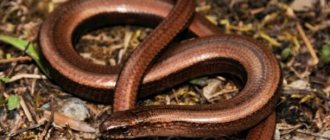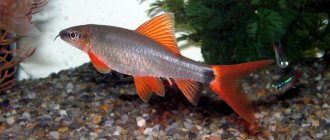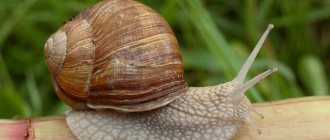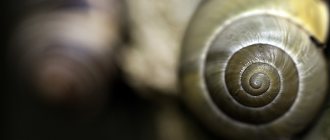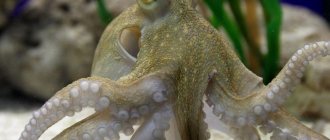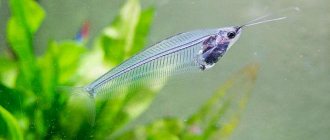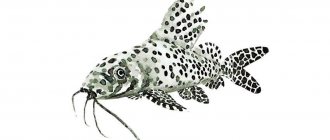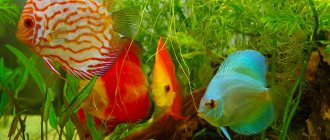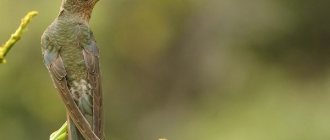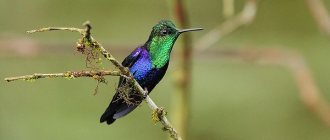Recently, you can buy a variety of exotic fish in pet stores. One of the most unusual, but very remarkable inhabitants of aquariums is the dwarf tetradon. Many people know very little about this cute and funny fish, so they often make mistakes when keeping them.
HABITAT IN NATURE
In recent years, a lot of fish native to India have appeared. These include the denison barb, the dario dario and many other, not yet so popular species. But standing apart from them is the dwarf yellow tetradon. They are originally from the state of Kerala, in southern India. They live in the Pamba River, which flows from the mountains and empties into Lake Vembanad (where they also live). The Pamba River is slow-moving and rich in vegetation. This means that the dwarf tetradon is a completely freshwater fish, unlike all its relatives, who at least need salted water.
Description and features
The appearance and behavior of the dwarf tetradon (lat. Carinotetraodon travancoricus) makes it a very attractive and sought-after fish. The body is pear-shaped with a transition to a large head. It is quite dense with small spines that are not visible when the fish is calm, but if it is scared or worried about something, the fish
inflates like a ball and spikes become a weapon and protection.
However, such frequent transformation of it negatively affects health and it is impossible to specifically frighten the tetradon.
At the same time, the size of the dwarf tetradon reaches 2.5 cm. The anal fin is poorly expressed, the others are expressed by soft rays. Relative to the body, the fins look miniature and very mobile, like the wings of a hummingbird
.
The fish has large, expressive eyes that amaze with their mobility, but if the tetradon is looking at something, they will stand almost motionless.
Fish mouth
somewhat reminiscent of a bird's beak, with fused premaxillary and jaw bones, however, the fish is predatory and also has 4 plates of teeth, located two at the bottom and at the top.
Distinguishing a male from a female is a very difficult task. Sexually mature male tetradons are usually brighter in color than female fish of the same age and have a dark line along the belly. Tetradons come in a variety of colors, some of which form the names of the varieties of these fish.
Interesting Facts
- A dog fish's teeth grow throughout its life. Therefore, it is necessary to give snails: by breaking the shell, the tetradon grinds down its teeth;
- To make a fish swell like a ball, the easiest way is to pull it out of the water. However, this is not recommended: it is not good for the health of the fish, and the owner may get burned by the poison from the thorns on the predator’s skin;
- A special organ helps the tetradon swell: it fills with water or air, and when the danger disappears, it gradually deflates;
- Many tetradons like to bury themselves in the ground, leaving only their muzzle on the surface.
Content
Taking into account the characteristics of tetradons, the following conditions can be distinguished for their comfortable life in an aquarium: Availability of clean fresh water. Individuals do not tolerate even slightly salted water; this can cause them to quickly die. On average, 5-7 liters of water is enough for one tetradon to live, sufficiently balanced in the amount of nitrates and ammonia (fish are sensitive to them). Maintaining sufficient temperature. Since they come from India, to keep them the water temperature must be kept constantly warm - about 23-26 degrees. Aquarium water must be clean.
Tetradons can easily eat only the required amount of food and leave the leftovers to rot. It is recommended to use a filter, and do not forget to fill it with clean water (about 20% of the total mass per week). Arrange the “interior” of the aquarium. These fish love to hide in plants and swim among snags, so you should take care of their presence in advance. In general, we can say that tetradons are quite unpretentious fish, they are able to adapt, you just need to take into account their unique characteristics. They prefer balance, so when it comes to arranging their home, you just need to avoid extremes. You should also remember that they are far from expert swimmers; it is not recommended to create a strong current in the water (do not use strong filters).
How to keep tetraodon
In order for the bubble fish to feel comfortable, it needs to create favorable conditions. They consist in selecting the right aquarium, equipment, design and regular care for the quality of water and cleanliness of the soil.
Arrangement of the aquarium
- Volume – from 150 l. The minimum allowable is from 110 l. If the fish has neighbors, then the larger the volume, the more comfortable it will be for all inhabitants. The exception is dwarf species of tetradons; tanks from 50 liters are suitable for them;
- Soil is very important for tetradons. Since these are voracious fish, waste products appear in large quantities. The soil helps the water stay clean longer. Fraction – any, ideally 3-5 or 5-7 mm;
- Filtration is extremely important to keep these fish healthy. Therefore, special attention should be paid to the choice of filter;
- Aeration – moderate, round the clock;
- Lighting – dim, subdued;
- Decor for tetraodons is unimportant. You can use any design elements: stones, driftwood, ceramic pipes. It will be nice if the tetradon can find a secluded place among the decor and hide. For some species, grottoes are a necessary measure;
- Living plants are welcome as they create secluded corners. It is better to plant them denser so that the plants form thickets;
- A lid on the aquarium is desirable.
Water parameters
- Temperature 23-28°C, depending on the type;
- Hardness 2-19°;
- Acidity 6.5-7.5 pH.
Maintenance and care
Water pollution must not be allowed, therefore:
- Mandatory regular cleaning of the soil, timely washing of the filter;
- Weekly change of 1/4 volume of water;
Nutrition
The biggest difficulty in keeping dwarf tetradons is proper feeding. No matter what the pet store tells you, fish don't touch pellets or flakes. In their natural habitat, they feed on invertebrates, snails and small insects. Therefore, at home you will have to provide them with the same diet, otherwise they will starve.
The best food options are squid (frozen) and small snails (melania, frieza). Tetradons will not refuse bloodworms, artemia and daphnia. Although they still prefer live food, which they can hunt for.
Whatever food you choose, the basis of your fish’s diet should be snails. They not only get enough of them, but also grind their teeth on their shells. This food will not be enough for a long time, so it is better to grow arthropods in another container and plant them in the aquarium with the tetradons as needed. It should be taken into account that fish will ignore large snails.
It is recommended to feed pets twice a day, giving food in small portions. Fish are prone to overeating, so there is no need to be overzealous.
Kinds
The Pufferfish genus has about 20 species, each of which has interesting behavior and color. The dwarf tetradon is not the only species loved by aquarists. In addition to it, the aquariums contain the following representatives:
- Tetradon eight is a common and beloved variety in Russia. The fish stretches up to 10 cm in length, the belly is light, and the sides and back are painted in a pleasant golden hue with patterns. The phenotype got its name due to the circles located on the back.
- Green tetradon, or spotted one, is a large representative, growing up to 25 cm. Green tetradon prefers to live in brackish water, so when kept at home, add salt to the liquid by adding 7 g/1 l. In addition, for the comfort of a green fish, living vegetation and a separate body of water are required - pets are tolerant of their relatives, but they can kill other fish.
Compatibility
The dwarf tetradon is a very quarrelsome neighbor that will not leave other inhabitants of the aquarium alone. Therefore, it is better to keep such fish separately, especially since they do not need a large displacement. Tetradons are very territorial, and in the fight for their space they can be extremely aggressive. This often results in the death of their rivals, even if they are larger. Among those with whom pufferfish predators can exist in peace for some time: otocinclus and shrimp.
A fairly large flock of tetradons can live in one aquarium, but only if there is a sufficient amount of food and shelter.
Adviсe
- Do not provoke fish to swell into a ball, because this is a protective mechanism that is accompanied by severe stress. Do not disturb the fish unless necessary, do not knock on the glass or touch them.
- If the fish behave like spawning, but you do not see eggs, walk along the ground with a small hose. There will be eggs among the drained water.
- Store-bought frozen food is not the best option, since the aquarist has no knowledge of the quality of the food and how it was stored. A safe option is to make homemade frozen food. Freezing as a method of processing fish food is very effective.
- Wash your hands when handling the aquarium. Cleaning equipment must be free of traces of detergents.
Dwarf tetradons are said to be poisonous. Large animals that eat them die due to the poisonous mucus or fish needles. If you need to come into contact with tetradon, make sure that there are no scratches or other damage on your hands.
Previous
Fish Tips for keeping a large cleaner - brocade catfish!
Next
FishWhat you need to know to breed barbs in an aquarium
Reproduction
Dwarf tetradons form a short-term pair of a male and a female and arrange preliminary games. The male, having fluffed out his dorsal and ventral crests, circles around the female. If she reciprocates, she will follow the male to his designated spawning location, lay her eggs and swim away. The male will remain to fertilize her. This procedure can be repeated several times. The male usually chooses a spawning site in dense thickets of plants or in thickets of aquarium mosses. The area with the laid eggs will be such that the male can protect it from other annoying males.
The male dwarf tetradon will guard the territory with eggs and ventilate it until the young hatch. Females do not take any part in caring for eggs and raising offspring. The fry are born large enough for such a small fish, and are immediately able to take newly hatched brine shrimp, although not all fry are born so large. Hobbyists often manage to breed tetradons at home.
Who do dwarf snailophiles get along with?
All tetradons are quite active, mobile and willful, and dwarf ones are no exception. Different owners have opposite opinions about their livability. For some, these small inhabitants coexist peacefully with other living creatures, while for others, they mercilessly eat the fins of their neighbors and terrorize them.
It is best to keep a flock of these bullies separately, without putting anyone in danger. You can add large shrimp to them, but these little pufferfish will feed on small ones. If, nevertheless, tetradons end up in a common aquarium, a spacious container with abundant vegetation will help reduce their aggression. The same applies to their individual content.
Although it is difficult to predict how these little tyrants will behave towards other inhabitants, the best company for them can be called:
- iris;
- otocinclus;
- zebrafish;
- rasborov espey;
- cherry and amano shrimp;
- Ramiresi's Apistogram;
- discus.
But it is not recommended to house yellow pufferfish with the following aquatic inhabitants:
- veiled tails;
- small shrimps;
- guppy;
- platies;
- cichlids;
- predatory catfish.
Keeping the fry
Tetradon caviar is transparent, up to approximately a millimeter in size. On average, one female produces about a hundred eggs. Parents are not sentimental and may well eat their future offspring.
Experienced aquarists collect fertilized eggs using a pipette or other devices and send them to safer conditions. In this case, milky white eggs are rejected; most likely they are unfertilized or diseased. A small cage with water from a community aquarium will be enough for the fry to appear. Temperature and other requirements are the same as described earlier, a special filter is needed, without the risk of absorbing eggs or fry. Algae and moss from the parent site will also be useful.
You should wait about a week and larvae will appear from the eggs - future tetradons. For the first three days they do not need feeding from reserves from the yolk sac. Having settled in a new place, the fry more and more resemble brave little ones - tetradons; fine food such as ciliates and microworms will ensure their further development, and after a month, the little ones will try “adult” food for the first time - frozen bloodworms.
After two months, they reach a length of one centimeter and can themselves hunt small inhabitants of their environment.
Breeding
Dwarf tetradons reproduce well in captivity, especially when optimal conditions are created for this. To get a new generation of these babies, it is necessary to place the mating couple, the entire flock, or create a kind of harem with the participation of one “master” and several “wives” in the spawning area. The latter option is preferable for many reasons.
- In this way, you will get much more fry, since one female releases only 7–10 eggs.
- The male will be busy with several girlfriends at once and will not be able to drive them half to death.
- There will be no fights between several males for possession of a female. Small but cocky fish fight until one of them dies.
You should first place a variety of small or thin-leaved plants in the spawning aquarium. Mosses, ambulia, and cabomba are most suitable. The water should be very warm, at least 25°.
Having relocated the future parents, they begin intensive feeding. Before spawning, it is recommended to feed the fish only with live food and snails. The male signals his readiness to breed by changing his color to darker and brighter. At this time, he begins to rush after the females, biting their sides. The running ends in a thicket of plants, where the couple begins to reproduce. The female releases eggs, and the male releases milk.
Sex differences
The fry look exactly the same, but the adult fish can be distinguished. Males have a dark stripe along the abdomen; females lack it. But “girls” have a slightly fuller and rounder tummy.
Getting offspring
Small transparent eggs do not have an adhesive substance, so they simply fall onto the ground or plants. To prevent them from getting into the teeth of their own parents, they need to be moved to a separate aquarium. The easiest way to do this is with a pipette or tweezers. Opaque whitish caviar must be disposed of - these are usually contaminated with fungi and are infertile.
In the aquarium for fry, it is necessary to create conditions that are optimal for adult tetradons. True, not just any filter will suit them! You cannot equip the container with a device that can suck in small fish.
The fry emerge from the eggs in 3–5 days and first feed from the yolk sacs. They begin to be given food on the third or fourth day. In the first week, you can feed only very small organisms such as ciliates and microworms. Then the fry are transferred to Artemia nauplii for about a month. For older fish, the diet is enriched with small snails and frozen food.
Be sure to sort the fry to prevent cannibalism. More developed individuals will gladly eat weak and small relatives.
Diseases
This small predator gets sick very rarely. Most often, the cause of illness is improper care and poor living conditions. Poisoning with ammonia compounds. The gills suffer the most; they become inflamed, turn red and increase in size. The fish breathes with difficulty and prefers to stay close to the surface. The problem can be eliminated by installing a good filter, frequent water changes, siphoning the bottom and adding zeolite to the water - a drug that absorbs excess ammonia. Nitrate poisoning. A sick fish first becomes agitated, moves erratically, and reacts to the slightest stimuli.
Then convulsions develop, the tetradon goes to the bottom. All his fins and gills are spread out, his mouth is open. Sick fish should be immediately placed in a temporary aquarium with clean water, and in a permanent aquarium, thoroughly siphon the bottom, replace half of the water with fresh water, rinse the filter and add substances that neutralize nitrates. Dropsy. The tetradon's abdomen is strongly inflated, and its scales are raised. The color loses intensity and brightness. Most likely, your tetradon is lacking food. Increase the diet, improve its quality, switch the fish only to live food and be sure to feed snails. Lifespan If kept in good conditions, the tetradon can live for about 5 years.
Feeding
Tetraodons must receive sufficient amounts of protein food. These can be snails, small shrimp, bloodworms, daphnia, tubifex, worms, crustaceans, and fry.
Sometimes you can give special dry food for predatory fish species. But it should be remembered that tetraodon teeth need tough and hard food, they must be regularly ground down.
If you purchase young tetraodons at the same time as juvenile zebrafish, rasboras, rainbowfish, and discus fish, you can try placing them in one large aquarium. But if the neighbors’ fins begin to suffer, then it is better to stop this experiment and resettle the dog fish.
Results
As already mentioned, there are a huge number of different types of tetradons. And each of them requires a special approach. So, for example, what a green tetradont prefers may not suit another species. But there are main points of content that are common to everyone. So, first of all, you should always maintain the temperature within 24-26 degrees, do not forget about aeration and in no case overfeed.
It is also recommended to learn a little about the conditions of the selected species before making a purchase.
Tetradon price
In specialized stores, or from aquarium fish lovers, you can buy tetradon, and even a whole flock. Yellow notebooks cost from two hundred rubles. Green tetradons will be a little more expensive, from three hundred rubles.
Tetradon Kutkutya
